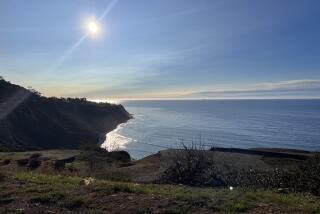U.S. Considering Air Traffic Reform for Southland Skies
WASHINGTON — The near-collision of two jetliners over Orange County on Feb. 13 has prompted federal officials to consider changes in air traffic control for much of Southern California, officials said Monday.
The National Transportation Safety Board is meeting today to consider the results and recommendations from a staff investigation into the “loss of standard separation” between a British Airways jumbo jet and an American Airlines jetliner Feb. 13 above Westminster.
The planes came within 1.9 miles of each other, both at 9,000 feet. Federal Aviation Administration officials said at the time that the British Airways pilot had to make a quick turn to avoid a collision.
The American Airlines plane had been diverted from John Wayne Airport because of a power outage had blacked out the unway lights.
Although the planes were not close enough for the incident to be classified as a “near miss,” FAA rules say they should have been apart at least 3 miles horizontally and 1,000 feet vertically.
The British jet, a Boeing 747, was carrying 286 people from Los Angeles to London. The American Airlines plane, a British Aerospace 146 with 70 people aboard, was headed for a landing at Ontario Interna
tional Airport after being diverted from John Wayne.
Wayne Pollock, the safety board investigator who has been handling the investigation, recently said that the crews of both planes had committed no errors and that the two aircraft were “where they were told to be.”
Pollock said the investigation had turned to whether one air traffic controller gave incorrect information to another. The British jet was being guided by air traffic controllers in Los Angeles. The American Airlines plane was being directed by controllers at Coast Terminal Radar Approach Control, the FAA’s regional facility at El Toro Marine Corps Air Station, known as Coast Tracon.
Awaiting Analysis
A week ago, Pollock said he was awaiting analysis of the voice communication between the controllers.
The investigation was also expanded to cover seven other operational errors over the last year at Coast Tracon, which handles about half a million flights a year between Los Angeles and San Diego, one of the busiest flight areas in the country outside major airport control zones.
The safety board’s inquiry is its first major investigation into an air traffic control operation since it recommended upgrading Chicago’s O’Hare International Airport after operational errors increased in 1986. O’Hare had more than 30 flight-handling errors in 1988. The FAA ordered several changes, including hiring more controllers.
The staff report on the Feb. 13 incident recommends several changes at Coast Tracon.
Among proposals to be voted on by the board are increases in staff members and more training of personnel, improvements and expansion of the facility and several technical changes, according to a board source who spoke on condition of anonymity.
An FAA official told The Times last month that Coast Tracon remains understaffed and requires some of its controllers to work overtime. At the end of January, Coast Tracon was authorized to have 97 controllers, yet had just 81.
The Times reported similar problems at the facility more than 2 years ago.
The safety board meeting on Southern California air traffic control problems comes 2 days after two reported near-collisions involving airliners in the New York City area.
Close Call at Kennedy
A TWA jumbo jet from London and a commuter plane were reported to have come within about 100 feet as they approached Kennedy International Airport for landing Sunday.
Then 45 minutes later, a Pan Am Boeing 727 en route from LaGuardia Airport to Boston reported coming within 400 yards of a small plane near Westchester County Airport.
The five-member board could expand its recommendations to cover other facilities if it decides any problem is widespread, but only conditions at Coast Tracon are on the agenda.
BUSH’S RIGHT OF WAY--President’s aircraft to get wide berth in O.C. Part II, Page 4.
More to Read
Sign up for Essential California
The most important California stories and recommendations in your inbox every morning.
You may occasionally receive promotional content from the Los Angeles Times.










